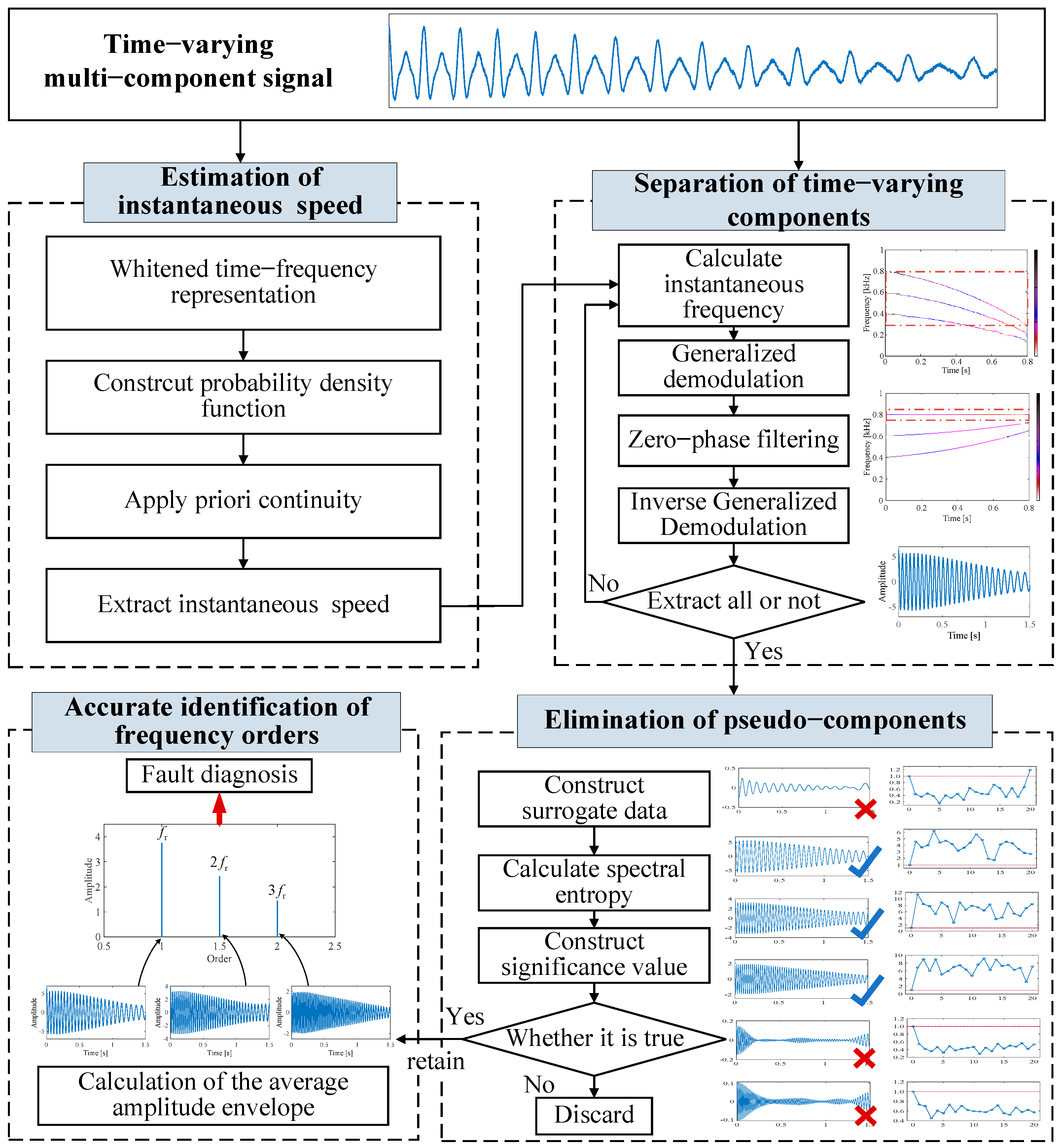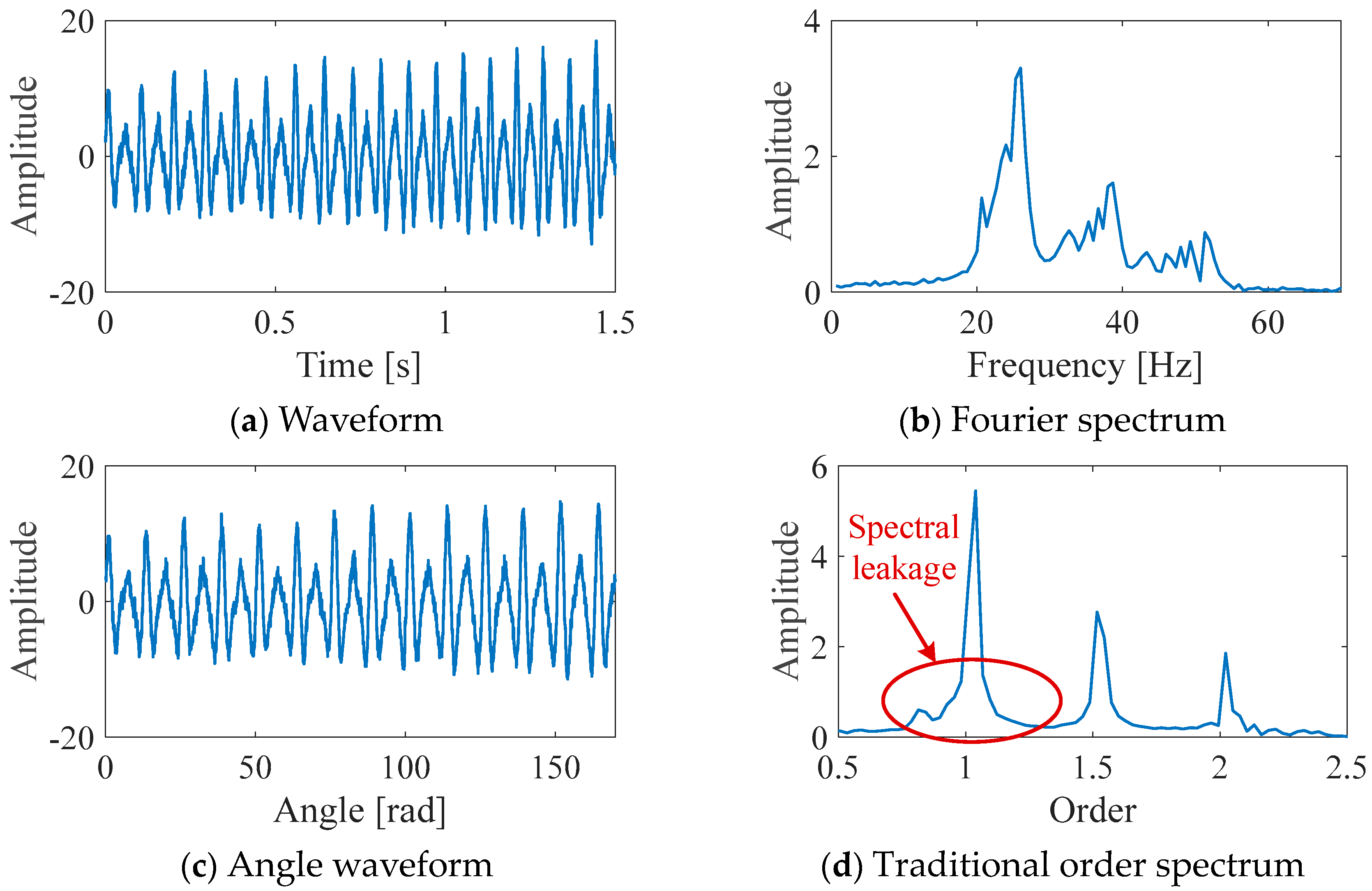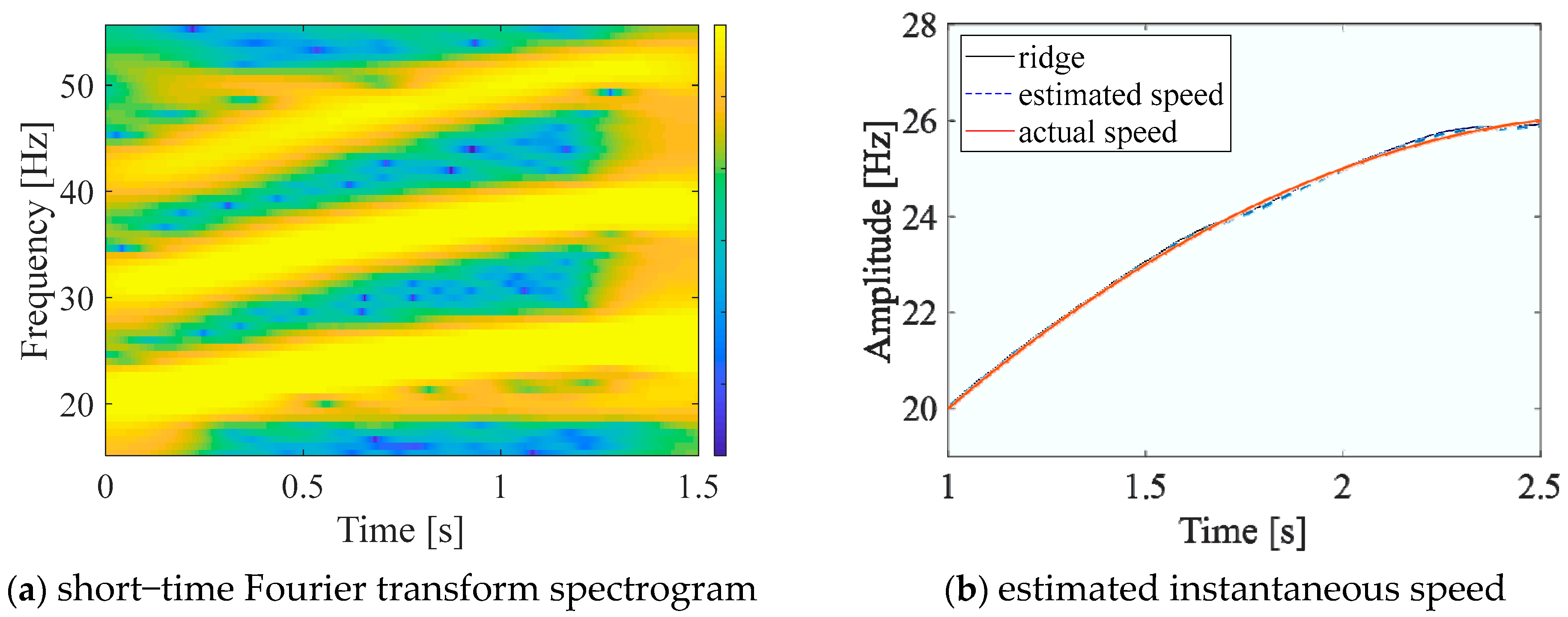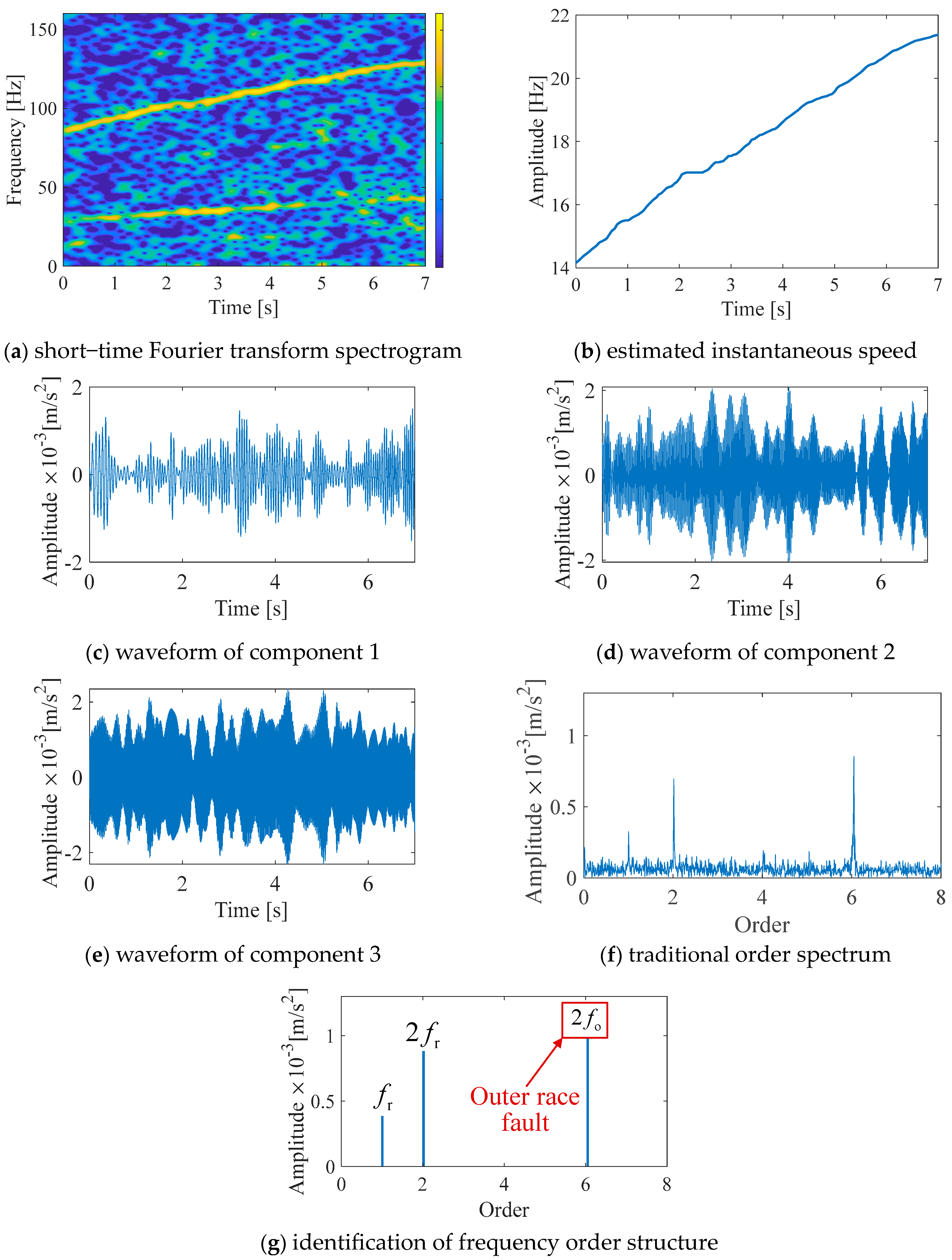Rotating Machinery Fault Diagnosis under Time–Varying Speed Conditions Based on Adaptive Identification of Order Structure
Abstract
:1. Introduction
- Avoid the inconvenience and error of speed measurement.
- Eliminate the interference of irrelevant components and noise.
- Avoid spectral energy leakage and achieve fine resolution.
2. The Proposed Fault Diagnosis Method
2.1. Estimation of Instantaneous Rotational Speed
2.2. Adaptive Separation of Time–Varying Components
2.3. Elimination of Pseudo–Components
2.4. Accurate Identification of Frequency Orders
2.5. Procedure of the Proposed Method
3. Performance Evaluation by Numerical Simulation Analysis
4. Experimental Validations for Rolling Element Bearing Fault Diagnosis
4.1. Experiment Settings
4.2. Signal Analysis
5. Conclusions
Author Contributions
Funding
Data Availability Statement
Conflicts of Interest
References
- Cheng, Y.; Chen, B.Y.; Zhang, W.H. Adaptive Multipoint Optimal Minimum Entropy Deconvolution Adjusted and Application to Fault Diagnosis of Rolling Element Bearings. IEEE Sens. J. 2019, 19, 12153–12164. [Google Scholar] [CrossRef]
- Rafiq, H.J.; Rashed, G.I.; Shafik, M.B. Application of multivariate signal analysis in vibration–based condition monitoring of wind turbine gearbox. Int. Trans. Electr. Energy Syst. 2021, 31, e12762. [Google Scholar] [CrossRef]
- Qin, A.S.; Hu, Q.; Zhang, Q.H.; Lv, Y.R.; Sun, G.X. Application of sensitive dimensionless parameters and PSO–SVM for fault classification in rotating machinery. Assem. Autom. 2019, 40, 175–187. [Google Scholar] [CrossRef]
- Xu, X.L.; Liu, X.L. Fault Diagnosis Method for Wind Turbine Gearbox Based on Image Characteristics Extraction and Actual Value Negative Selection Algorithm. Int. J. Pattern. Recognit. Artif. Intell. 2020, 34, 2054034. [Google Scholar] [CrossRef]
- Peng, G.; Xu, D.; Zhou, J.; Yang, Q.; Shen, W. A novel curve pattern recognition framework for hot–rolling slab camber. IEEE Trans. Ind. Inform. 2022, 19, 1270–1278. [Google Scholar] [CrossRef]
- Peng, G.; Cheng, Y.; Zhang, Y.; Shao, J.; Wang, H.; Shen, W. Industrial big data–driven mechanical performance prediction for hot–rolling steel using lower upper bound estimation method. J. Manuf. Syst. 2022, 65, 104–114. [Google Scholar] [CrossRef]
- Fyfe, K.R.; Munck, E.D.S. Analysis of Computed Order Tracking. Mech. Syst. Signal Process. 1997, 11, 187–205. [Google Scholar] [CrossRef]
- Lu, S.; Yan, R.; Liu, Y.; Wang, Q. Tacholess Speed Estimation in Order Tracking: A Review With Application to Rotating Machine Fault Diagnosis. IEEE Trans. Instrum. Meas. 2019, 68, 2315–2332. [Google Scholar] [CrossRef]
- Xu, L.; Ding, K.; He, G.; Li, W.; Li, J. A novel tacholess order tracking method for gearbox vibration signal based on extremums search of gear mesh harmonic. Mech. Syst. Signal Process. 2023, 189, 110070. [Google Scholar] [CrossRef]
- Potter, R.; Gribler, M. Computed Order Tracking Obsoletes Older Methods. In Proceedings of the SAE Noise and Vibration Conference, West Palm Beach, FL, USA, 8–10 February 1989; pp. 63–67. [Google Scholar]
- Li, B.; Zhang, X. A New Strategy of Instantaneous Angular Speed Extraction and Its Application to Multistage Gearbox Fault Diagnosis. J. Sound. Vib. 2017, 396, 340–355. [Google Scholar] [CrossRef]
- Rémond, D.; Antoni, J.; Randall, R. Editorial for the special issue on Instantaneous Angular Speed (IAS) processing and angular applications. Mech. Syst. Signal Process. 2014, 44, 1–4. [Google Scholar] [CrossRef]
- Peeters, C.; Leclère, Q.; Antoni, J.; Lindahl, P.; Donnal, J.; Leeb, S.; Helsen, J. Review and comparison of tacholess instantaneous speed estimation methods on experimental vibration data. Mech. Syst. Signal Process. 2019, 129, 407–436. [Google Scholar] [CrossRef]
- Zhao, M.; Lin, J.; Xu, X.; Lei, Y. Tacholess envelope order analysis and its application to fault detection of rolling element bearings with varying speeds. Sensors 2013, 13, 10856–10875. [Google Scholar] [CrossRef]
- Hu, Y.; Cui, F.; Tu, X.; Li, F. Bayesian estimation of instantaneous speed for rotating machinery fault diagnosis. IEEE Trans. Ind. Electron. 2021, 68, 8842–8852. [Google Scholar] [CrossRef]
- Gu, L.; Tian, Q.; Ma, Z. Extraction of the instantaneous speed fluctuation based on normal time–frequency transform for hydraulic system. Proc. Inst. Mech. Engineers. Part C J. Mech. Eng. Sci. 2020, 234, 1196–1211. [Google Scholar] [CrossRef]
- Leclère, Q.; André, H.; Antoni, J. A multi–order probabilistic approach for instantaneous angular speed tracking debriefing of the CMMNO’ 14 diagnosis contest. Mech. Syst. Signal Process. 2016, 81, 375–386. [Google Scholar] [CrossRef]
- Peeters, C.; Leclere, Q.; Antoni, J.; Guillaume, P.; Helsen, J. Vibration–based angular speed estimation for multi–stage wind turbine gearboxes. J. Phys. Conf. Ser. 2017, 842, 012053. [Google Scholar] [CrossRef]
- Schmidt, S.; Heyns, P.S.; De Villiers, J.P. A tacholess order tracking methodology based on a probabilistic approach to incorporate angular acceleration information into the maxima tracking process. Mech. Syst. Signal Process. 2018, 100, 630–646. [Google Scholar] [CrossRef]
- Gryllias, K.; Andre, H.; Leclere, Q.; Antoni, J. Condition monitoring of rotating machinery under varying operating conditions based on cyclononstationary indicators and a multi–order probabilistic approach for instantaneous angular speed tracking. IFAC–PapersOnLine 2017, 50, 4708–4713. [Google Scholar]
- Wang, K.; Heyns, P.S. The combined use of order tracking techniques for enhanced fourier analysis of order components. Mech. Syst. Signal Process. 2011, 25, 803–811. [Google Scholar] [CrossRef]
- Wang, K.; Guo, D.; Heyns, P.S. The application of order tracking for vibration analysis of a varying speed rotor with a propagating transverse crack. Eng. Fail. Anal. 2012, 21, 91–101. [Google Scholar] [CrossRef]
- Zhao, M.; Lin, J.; Wang, X.; Lei, Y.; Cao, J. A tacho–less order tracking technique for large speed variations. Mech. Syst. Signal Process. 2013, 40, 76–90. [Google Scholar] [CrossRef]
- Coats, M.D.; Randall, R.B. Single and multi–stage phase demodulation based order–tracking. Mech. Syst. Signal Process. 2014, 44, 86–117. [Google Scholar] [CrossRef]
- Blough, J.R.; Brown, D.L.; Vold, H. The time variant discrete Fourier transform as an order tracking method. SAE Trans. 1997, 106, 3037–3045. [Google Scholar]
- Borghesani, P.; Pennacchi, P.; Chatterton, S.; Ricci, R. The velocity synchronous discrete Fourier transform for order tracking in the field of rotating machinery. Mech. Syst. Signal Process. 2014, 44, 118–133. [Google Scholar] [CrossRef]
- Xu, S.; Zhang, Y.; Pham, D. Antileakage Fourier transform for seismic data regularization. Geophysics 2005, 70, V87–V95. [Google Scholar] [CrossRef]
- Xu, S.; Zhang, Y.; Lambaré, G. Antileakage Fourier transform for seismic data regularization in higher dimensions. Geophysics 2010, 75, WB113–WB120. [Google Scholar] [CrossRef]
- Schonewille, M.; Klaedtke, A.; Vigner, A. Anti–alias anti–leakage Fourier transform. In Proceedings of the SEG International Exposition and Annual Meeting, Houston, TX, USA, 25–30 October 2009; pp. 3249–3253. [Google Scholar]
- Zhang, F.; Geng, Z.; Yuan, W. The algorithm of interpolating windowed FFT for harmonic analysis of electric power system. IEEE Trans. Power Deliv. 2001, 16, 160–164. [Google Scholar] [CrossRef]
- Schreiber, T.; Schmitz, A. Surrogate time series. Phys. D Nonlinear Phenom. 2000, 142, 346–382. [Google Scholar] [CrossRef]
- Theiler, J.; Eubank, S.; Longtin, A.; Galdrikian, B.; Farmer, J.D. Testing for nonlinearity in time series: The method of surrogate data. Phys. D Nonlinear Phenom. 1992, 58, 77–94. [Google Scholar] [CrossRef]











| Bearing Parameters | Characteristic Frequency | |||
|---|---|---|---|---|
| Pitch Diameter | Ball Diameter | Number of Balls | BPFI | BPFO |
| 38.52 mm | 7.94 mm | 9 | 5.43fr | 3.57fr |
| Traditional Order Spectrum | Proposed Order Spectrum | |
|---|---|---|
| Is rotational speed data required? | Yes | No |
| Does energy leakage exist due to irrelevant components? | Yes | No |
| Does energy leakage exist due to nonstationarity? | Yes | No |
| Does error exist due to resampling? | Yes | No |
| Spectral energy concentration | Low | High |
Disclaimer/Publisher’s Note: The statements, opinions and data contained in all publications are solely those of the individual author(s) and contributor(s) and not of MDPI and/or the editor(s). MDPI and/or the editor(s) disclaim responsibility for any injury to people or property resulting from any ideas, methods, instructions or products referred to in the content. |
© 2024 by the authors. Licensee MDPI, Basel, Switzerland. This article is an open access article distributed under the terms and conditions of the Creative Commons Attribution (CC BY) license (https://creativecommons.org/licenses/by/4.0/).
Share and Cite
Yu, X.; Chen, X.; Du, M.; Yang, Y.; Feng, Z. Rotating Machinery Fault Diagnosis under Time–Varying Speed Conditions Based on Adaptive Identification of Order Structure. Processes 2024, 12, 752. https://doi.org/10.3390/pr12040752
Yu X, Chen X, Du M, Yang Y, Feng Z. Rotating Machinery Fault Diagnosis under Time–Varying Speed Conditions Based on Adaptive Identification of Order Structure. Processes. 2024; 12(4):752. https://doi.org/10.3390/pr12040752
Chicago/Turabian StyleYu, Xinnan, Xiaowang Chen, Minggang Du, Yang Yang, and Zhipeng Feng. 2024. "Rotating Machinery Fault Diagnosis under Time–Varying Speed Conditions Based on Adaptive Identification of Order Structure" Processes 12, no. 4: 752. https://doi.org/10.3390/pr12040752





